| Home | |
| Turnkey Systems | |
| Products | |
|
|
Pattern Generators |
|
|
Clock Drivers |
|
|
|
|
|
Data Acquisition |
|
|
Mainframes |
|
|
Accessories |
| Software | |
| About | |
| Support | |
| News | |
| Contact/Sales | |
| Pulse Research Lab | |
| Top | |
PI-41000 Digital Acquisition Card |
|
Products > Data Acquisition > PI-41000 |
|
Features:
Applications:
|

|
Introduction:The PI-41000-4G is a CompactPCI® bus based instrument card that allows the user to capture up to 32-bits of digital data into an on-board memory at clock rates up to 120 MHz. The inputs are software configurable to provide one 32-bit wide channel, one 16-bit wide channel with double depth or two 16-bit channels. When configured with a single 16-bit input, the card will capture at up to 120 MHz. When configured with two 16-bit inputs or as a single 32-bit input, the card will capture at up to 80 MHz. Each digital data channel requires three timing signals, frame, line and pixel to accommodate the data capture. When operating in a two channel mode, clocks from channel A can be used to provide timing to channel B. For wider words or multiple channels, more boards can be used in parallel. Memory Storage:The PI-41000-4G Digital Acquisition Board has on-board memory of 4 GB. When the instrument is configured to operate as a single 16-bit channel the two input buffers are combined to maximize the memory depth. Data Acquisition and Inputs:The PI-41000-4G was designed primary for image capture. To synchronize data, the board requires frame, line and pixel timing signals. Each of these timing signals has an associated counter. The line and pixel counters when combined provide an important Area of Interest (AOI) feature. This feature provides the ability to capture a sub-image of a defined area on the imaging device. The Area of Interest acquisition provides for an efficient use of the capture memory. Data can be collected on a defined pixel area of the imager without acquiring and storing the complete image. By using the AOI feature the user can process and display and area of any size up to 64K x 64K pixels. The input levels for both data and clocks are 3.3V CMOS or LVDS. The inputs for data and timing signals are terminated with approximately 1 KOhm. To minimize reflections the drive for the data and timing signals should be a back-matched with 50 ohms. As an option the input impedance of data and/or timing signals can be changed to 50 ohms. The data input is via two 40 pin header connectors. The timing signal connectors are Micro-D. The PI-41000-4G can be used by itself in a CompactPCI-based test system, or as the digital acquisition component of the PI-3105 Multi-Channel Data Acquisition System or of a fully-integrated, turnkey imager test system. Data Transfer and Software:The PI-41000-4G is capable of becoming a bus master and therefore uses DMA to transfer the captured data to from the on-board memory to the Host CPU. The PI-41000 is supported by Pulse Instruments’ PI-DATS and PI-Controller software. DLLs, documentation, and sample code are also available to facilitate integration into custom applications written in C++, VisualBasic, VBA, LabVEW, HTBasic, IDL, or MATLAB. | |
Ordering Information:Contact Pulse Instruments Sales at (310) 515-5330 or by email at sales@pulseinstruments.com | |
Block Diagram | Specifications | Datasheet |
|